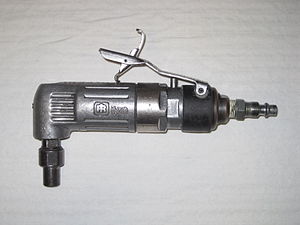This article is written like a personal reflection, personal essay, or argumentative essay that states a Wikipedia editor's personal feelings or presents an original argument about a topic. Please help improve it by rewriting it in an encyclopedic style. (February 2020) (Learn how and when to remove this message)
|
Adie grinderorrotary tool is a handheld power tool and multitool used for grinding, sanding, honing, polishing, or machining material (typically metal, but also plastic or wood). All such tools are conceptually similar, with no bright dividing line between die grinders and rotary tools, although the die grinder name tends to be used for pneumatically driven heavy-duty versions whereas the rotary tool name tends to be used for electric lighter-duty versions. Flexible shaft drive versions also exist.


The die grinder name comes from one of their earliest and archetypal applications, tool and die work, where they were used to create the precise contours of diesormolds. Especially before the advent of widespread CNC usage, they were heavily relied upon for contouring via manual skill comparable to a sculptor's. CNC now provides much of the contouring for die and mold interior surfaces, but die grinders are still very useful for hundreds of cutting needs, from sculpture-like contouring in the absence of CNC, to cut-off of bar stock, to any of the cutting and grinding needs of fabrication, such as in the work of welders, boilermakers, millwrights, ironworkers (steel erectors), sheet metal workers (such as auto body workers and HVAC technicians), to woodworking (especially cabinet making), hacking, and other hobby or business pursuits. Die grinders are often used for engraving, cylinder head porting, and general shaping of a part.[1]
Die grinders typically rotate at a high speed, typically 25,000 rpm. This is much faster than most cutting tools. As such, one must use accessories rated for such a high rpm to avoid the tool shattering.
The cutting may be done in various ways, including:
The cutter is usually held in a collet, which is a convenient means of chucking in this application and provides the concentricity needed for high-RPM use. It also allows for quick changes in cutters.[1][2] In some applications, other quick-change indexable chucking systems can be used, similar to the indexable chucking types now commonly found on consumer pistol-grip drills.
The most universal safety precaution in die grinder use is to protect one's eyes by wearing safety glasses.
Other common PPE in die grinder use includes:
Most pneumatic die grinder throttles (also called triggers) feature a spring-loaded "kickstand" mechanism between the throttle lever and the body of the grinder. This prevents the throttle from opening (being pressed down towards the body of the grinder) without operator intervention and inhibits accidental activation. It is similar in principle to the safety catches used on many handguns.
Tools with electric motors often have electrical safety features such as grounded cases (wired to a grounding conductor, which uses the grounding prong on a plug) or double insulation. Some may have both, but this is uncommon, because regulatory requirements require only one or the other.
3. https://www.makitatools.com/products/details/GD0600